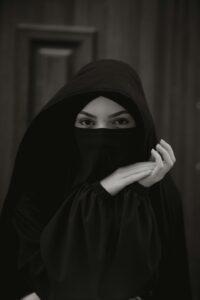The Hijab (Head Scarf)

The hijab is an important part of a Muslim woman’s identity and a personal act of devotion and worship. Both the Qur’an and the Hadith guide Muslim women to cover their hair and wear clothing that doesn’t emphasize their physical appearance when they’re outside their home or in the presence of men who could potentially be marriage candidates.
As I briefly made mention on page 16, when a Muslim woman chooses to wear the hijab, it is a lifelong commitment (kind of like a tattoo); it’s not something you just put on and take off like a baseball hat. It’s a commitment to God! Taking it off is nearly impossible or unimaginable.
In Islam and in Christianity:
The hijab in Islam and the attire worn by Christian nuns both symbolize modesty, piety, and devotion to faith. Maryam (Mary), the mother of Jesus (Peace be upon them both), is often seen as a symbol of chastity and virtue, and her example is reflected in the practice of wearing a headscarf to cover her hair, which represents a commitment to modesty and spirituality. Similarly, Christian nuns wear habits, including head coverings, and a tunic which does not emphasize their physical appearance, as a sign of their dedication to God and their vow of humility.
Question: Does not wearing the hijab make a woman any less of a Muslim?
The Prophet Muhammad (pbuh) said: ” God does not look at your bodies nor your appearances, but He looks at your hearts and your deeds”.
Wearing the hijab is an important act of devotion in Islam, but it is not one of the five pillars of Islam. If a woman chooses not to wear the hijab, perhaps because she fears she won’t be able to remove it later, that does not make her any less of a Muslim. She is still a Muslim, and it is her faith, actions, and relationship with God that truly define her. Muslims are encouraged to treat one another with kindness, understanding, and support as everyone finds their own path toward God.
The Niqab (Face Covering)

How a woman fulfills the requirements of the hijab varies from culture to culture, but historically, the face covering was practised by many cultures before Islam and scholars say the adoption of its practice by Muslims was part of fitting into these societies (which goes against the progress brought to women by Islam).
The niqab (face covering) has brought a lot of negative attention to Islam and what it represents in Western societies.
Unfortunately, in a lot of cases what non-Muslims know most about Islam is the niqab, terrorism, and the Middle East conflict.
For these reasons, some scholars have asked Muslim women to refrain from wearing the niqab in the west because it can lead to harassment for them and act as a barrier to inviting people into the true Islam (not the one portrayed by the media). Muslim women who refuse to hear the call of the scholars and choose to wear the niqab should keep in mind that they are the ambassadors of Islam in the west and the Niqab is not the best example.
I would kindly ask these women: Did you know that it’s actually Haram (forbidden) for a woman to cover her face during Ihram state in Makkah during Umra or Hadj?
If you’re a Muslim woman who wears the niqab and you’re unsure if it should be removed, think about this: If wearing the niqab was really mandatory, why would it be haram for women to cover their face and hands while in the special state of Ihram (a time of purity and focus before entering the rituals of pilgrimage during Hajj or Umrah in Makkah), which is one of the most important acts in Islam?
The Prophet Muhammad (pbuh) said: “Women in the state of Ihram are not to cover their faces, nor to wear gloves.” (Sahih al-Bukhari, Book 25, Hadith 1; Sahih Muslim, Book 7, Hadith 2845).
